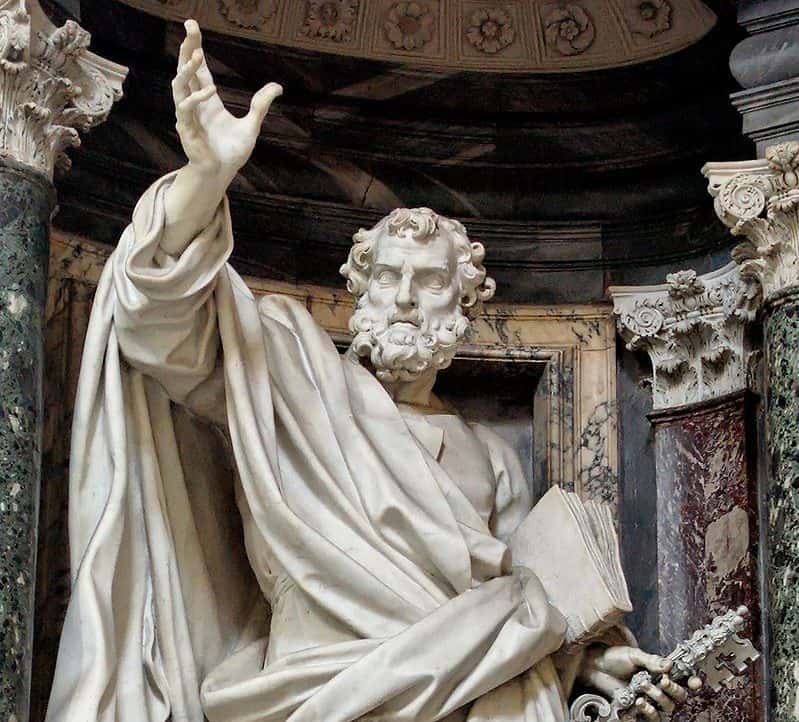by Dr. James Ricks
The internet is buzzing about Pope Francis authenticating the latest discovery of the Apostle Peter’s bones. It is a fascinating story of an American billionaire and an Italian archaeologist who worked for many years. They found the bones in Rome and an inscription that was translated by the one person who could translate it, the brilliant archaeologist, Margherita Guarducci. The message read “Peter is here.”
This discovery contradicts an earlier discovery of Peter’s bones. The supporting evidence has convinced the current Pope to authenticate this find. The finding of such ancient sacred relics in this world gives the owner authenticity and power. In the 11th century ancient relics and archaeological findings were connected with lots of relic trafficking and forgeries. These findings did help bolster the existence of Christianity in various cities of the ancient world. What does God think of these relics as spiritual items and icons?
Jude 1:8-9, “Likewise, indeed, also these dreaming ones even defile flesh, and despise rulership, and speak evil of glories.
“But Michael, the archangel, when contending with the Devil, he argued about the body of Moses, he dared not bring a judgment of blasphemy, but said, Let the Lord rebuke you!” (MKJV)
Clearly the devil was prevented by archangel Michael from taking and using the body and bones of Moses for idolatrous purposes. Moses is an even greater Biblical figure than Peter.
No doubt evil forces would have used Moses’ bones as an idol. People would have started looking to the bones of Moses instead of the true God. They would have used the bones like a magic talisman. Obviously God stopped that plan. God does not like using ancient relics for spiritual purposes. But this world has and will continue to do so. God does not want any idols used to worship Him. This includes even pictures of what we think God looks like.
Deut. 5:8-9, “You shall not make a graven image for you, any likeness of anything that is in the heavens above, or in the earth beneath, or in the waters beneath the earth.
“You shall not bow yourself down to them, nor serve them. For I the LORD your God am a jealous God, visiting the iniquity of the fathers upon the sons to the third and fourth generation of those who hate Me.”
1 Corinthians 10:14, “Therefore, my dearly beloved, flee from idolatry.”
Whether they have Peter’s bones or not, bones do not advance true worship. True Christianity is based on the Bible. However, the Roman Catholic Church and the Papal line of succession is strengthened in this world by the belief that they have finally got Peter’s real bones.
Peter was never the undisputed leader of all the apostles. Peter is clearly a leader among the Apostles and often the first one to speak up at events like Pentecost. However he was not the leader. Did the other Apostles treat Peter like he was their leader? They did not! During the first major church conference in the history of the church regarding gentiles being exempted from circumcision, James was clearly the leader, and not Peter.
Acts 15:13, “And after they had held their peace, James answered, saying, Men and brethren, hearken unto me…”
V. 17, “That the residue of men might seek after the Lord, and all the Gentiles, upon whom my name is called, saith the Lord, who doeth all these things.”
V. 19, “Wherefore my sentence [judgement] is, that we trouble not them, which from among the Gentiles are turned to God:”
Later the Apostle Paul publicly and openly rebuked Peter for his ethnic prejudice brought on by pressure from visiting Jews from Jerusalem. If Peter was on a throne of rulership he would not have feared the other Jews nor have been openly rebuked by Paul. Paul would have done it privately.
Paul writes in Galatians 2:11-12, “But when Peter was come to Antioch, I withstood him to the face, because he was to be blamed.
“For before that certain came from James, he did eat with the Gentiles: but when t hey were come, he withdrew and separated himself, fearing them which were of the circumcision.”
Some feel the argument for Papal succession may be enhanced by the bones of Peter, but it is not supported by the Bible. Peter was a great Apostle and leader of the faithful. He was not considered during his lifetime as THE leader among all the other Apostles. Peter never claimed any such power.
1 Pet. 5:1-3, “The elders which are among you I exhort, who am also an elder, and a witness of the sufferings of Christ, and also a partaker of the glory that shall be revealed:
“Feed the flock of God which is among you, taking the oversight thereof, not by constraint, but willingly; not for filthy lucre, but of a ready mind;
“Neither as being lords over [overruling] God’s heritage, but being ensamples to the flock.”
Peter said himself at Pentecost that Jesus is the Rock upon which the church was built. Note Acts 4:11-12:
“This is the stone which was set at nought of you builders, which is become the head of the corner.
“Neither is there salvation in any other: for there is none other name under heaven given among men, whereby we must be saved.”
Was the Apostle Peter ever in the city of Rome?
The answer is we do not know with absolute certainty about Peter ever being in Rome. The Bible, in the Acts of the Apostles, only tells of Paul being the first to arrive in Rome. One must rely upon secular history for both the presence of Peter in Rome and the ascendancy of the Bishop of Rome over other bishops.
Acts 28:16, “And when we came into Rome, the centurion delivered the prisoners to the camp commander. But Paul was allowed to dwell by himself, with a soldier guarding him…”
V. 22 “But we think it right to hear from you what you think. For truly as concerning this sect, it is known to us that it is spoken against everywhere.”
It is clear that the people of Rome knew very little about Christianity until Paul arrived. The Bible only recognizes Paul as evangelizing the city of Rome. This is the last item mentioned in the Acts of the Apostles. We must count on secular historians for Peter’s work in the city of Rome.
Most churches outside of the Roman Catholic Church do not accept the ascendancy of the Bishop of Rome. The problem with secular church history is that it is written by the winners. The dominant church powers of the first few centuries control much of church history.
The true church of God was small and scattered and did not have a lot of power. God did not intend the church to become a huge, powerful, political force. Christianity would only become a great moral force in the world.
We cannot be sure of Peter’s work in Rome. Maybe he went later or maybe he did not go at all. The true church had no power to control the historical record. It was prophesied to happen that way. God’s true church would be small and scattered, and most would find the path to Christ too difficult to walk. The church would be a small minority.
Matt. 7:13-14, “Enter ye in at the strait gate: for wide is the gate, and broad is the way, that leadeth to destruction, and many there be which go in thereat:
“Because strait is the gate, and narrow is the way, which leadeth unto life, and few there be that find it.”
The true church would be separated from the world and not seeking worldly power in this age. The real church would be relatively small! We believe much of what historians write about the church is of an apostate organization. Most of the apostasy took place after the lifetime of the Apostle Peter. He was not the first Pope. The Church he helped build would not be part of this world’s society. He was one of the leading Apostles, but his bones convey no spiritual cache––if they even are his bones.
John 17:13-16, “And now come I to thee; and these things I speak in the world, that they might have my joy fulfilled in themselves.
“I have given them thy word; and the world hath hated them, because they are not of the world, even as I am not of the world.
“I pray not that thou shouldest take them out of the world, but that thou shouldest keep them from the evil.
“They are not of the world, even as I am not of the world.”
How did the true church of God get derailed and pushed out of the mainstream of this world’s society? God allowed deceivers to come into the church to send large parts of the church into worldly, ungodly directions.
1 John 2:19, “They went out from us, but they were not of us; for if they had been of us, they would no doubt have continued with us: but they went out, that they might be made manifest that they were not all of us.”
Later on, as the deceivers gained more influence and followers, they started to remove the true believers from among them. All such political maneuverings left the true church meager and disbursed and unnoticed by historians.
3 John 1:9-10, “I wrote unto the church: but Diotrephes, who loveth to have the preeminence among them, receiveth us not.
“Wherefore, if I come, I will remember his deeds which he doeth, prating against us with malicious words: and not content therewith, neither doth he himself receive the brethren, and forbiddeth them that would, and casteth them out of the church.”
The Apostle John told those remaining with the full truth to reorganize around Demetrius.
V. 12, “Demetrius hath good report of all men, and of the truth itself: yea, and we also bear record; and ye know that our record is true.”
Archaeology can be very helpful in supporting the truth of antiquity. Academia in the past has boasted that the Bible was full of errors. They claimed the Bible contained information that could not be independently and historically verified. But a slew of archaeological discoveries has put a damper upon most of that boasting. Archaeology has provided the world with some fascinating and amazing affirmations of Scripture’s accuracy and trustworthiness. Israel today is an engine now unveiling many new archaeological discoveries.
The Nabonidus Cylinder 550 BC is one. Critics of the Bible had claimed that Belshazzar was never king of Babylon and that Nabonidus was not his father. No evidence of this existed until the discovery of a magnificent cuneiform cylinder. The cylinder mentioned Belshazzar by name. Scholars were proven dead wrong.
The Tel Dan Stele 850 BC is another such discovery that supports the united kingdom of David. It was an upright stone monument with many details carved into it. Another monument with writings to support details in the book of Kings––including Kings Omri and David––is the Mesha Stele, also known as the “Moabite Stone,” 846 BC.
Digs in Israel have revealed hard physical evidence of Caiaphas the high priest and Pilate of the New Testament. They are the Caiaphas Ossuary and the Pilate Dedication Stone. Archaeology had to prove that writing even existed in the days of Moses when academia wished to deny it to discredit the Bible. Relics can be helpful, but not as spiritual icons or talismans.





